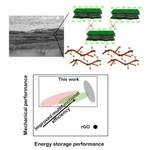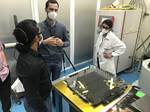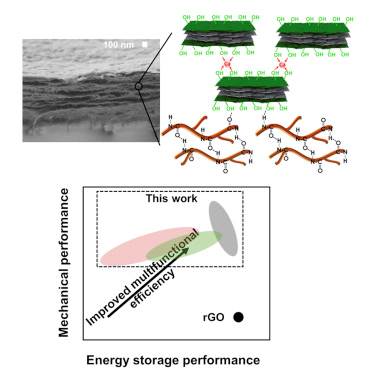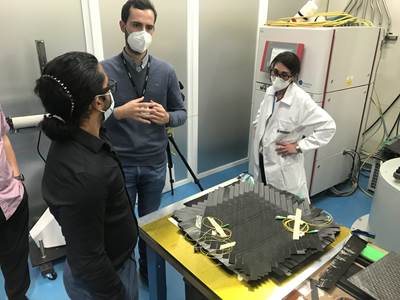RCCF of TU Dresden develops next-gen, 3D-printed structural supercapacitors
Thales Research and Technology leads PRINTCAP project for more sustainable fast-charging, structural energy storage for automotive and aerospace industries using multifunctional composite materials
Technology concept for the 3D continuous fiber-printed, free-form, structure-supporting PRINTCAP supercaps. Photo Credit: RCCF at TU Dresden
The “Next Generation of 3D Printed Structural Supercapacitors” (PRINTCAP) research project, led by four partners, including the (Germany), and under the chairmanship of (Palaiseau, France), addresses the development of a new generation of supercapacitors (SC) for fast-charging, structural energy storage for the automotive and aerospace industries through the incorporation of 3D printing and multifunctional composites. Since its kick-off in July 2022, partners have jointly discussed possible manufacturing routes and initial concept ideas, and have successfully defined first process steps. The project timeline runs June 2022 to May 2025.
Electric vehicles (EVs), free of local CO2 emissions, form the backbone of the EU’s 2030 climate framework. However, current energy storage systems used, especially batteries, increase vehicle weight to a considerable extent, and limit the freedom in vehicle design. Moreover, existing energy storage solutions are made of layers and stacking methods, which require shielding housings. Therefore, their integration often takes up valuable installation space.
Innovative structural supercapacitors (SSC), however, combine the energy storage function of SC with the high mechanical properties of lightweight composites — addressing weight reduction and opening up space. The SSC concept is said to open up a wide field of concrete applications such as fast-charging electric cars or parcel drones that store energy in their own chassis.
The PRINTCAP project is pursuing the production of SSC via additive manufacturing (AM) processes, to develop a near-neat shape SSC concept that combine weight- and space-optimized lightweight structures with the energy storage function. For direct transfer to industry, PRINTCAP aims to develop effective design and manufacturing concepts for structure-bearing, free-formed SSC, ranging from the concept phase to demonstration proof. The developed concepts will also include initial solutions for recycling the materials used, as well as lifecycle analysis (LCA) studies, in accordance with the cradle-to-cradle principle.
For this purpose, PRINTCAP draws on the expertise of the Research Center Carbon Fibers Saxony (RCCF) at the TU Dresden, among others. In addition, the (HTWK, Leipzig, Germany) is contributing its specialist knowledge in the composite design of multifunctional materials. Thales Research and Technology and (Aix-en-Provence, France) complement the team’s competencies with technological positions in the field of structural load-bearing electrolytes and the production of carbon nanotube (CNTs) based supercaps. With the synergetic combination of energy storage and lightweight construction, the PRINTCAP project reportedly lays the foundation for the free-form production of fast-charging, structure-supporting, resource-efficient energy storage devices.
Related Content
ASCEND program completion: Transforming the U.K.'s high-rate composites manufacturing capability
GKN Aerospace, McLaren Automotive and U.K. partners chart the final chapter of the 4-year, £39.6 million ASCEND program, which accomplished significant progress in high-rate production, Industry 4.0 and sustainable composites manufacturing.
Read MoreBio-based, fire-resistant composites become mainstream
Projects use Duplicor prepreg panels with highest Euroclass B fire performance without fire retardants for reduced weight, CO2 footprint in sustainable yet affordable roofs, high-rise façades and modular housing.
Read MoreLife cycle assessment in the composites industry
As companies strive to meet zero-emissions goals, evaluating a product’s carbon footprint is vital. Life cycle assessment (LCA) is one tool composites industry OEMs and Tier suppliers are using to move toward sustainability targets.
Read MoreJEC World 2024 highlights: Glass fiber recycling, biocomposites and more
CW technical editor Hannah Mason discusses trends seen at this year’s JEC World trade show, including sustainability-focused technologies and commitments, the Paris Olympics amongst other topics.
Read MoreRead Next
Multifunctional composites could help achieve structural supercapacitors for EVs
In a recent study, functionalized graphene/nanofiber electrodes showed 2X modulus, strength and 5-10X multifunctional efficiency.
Read MoreCAELESTIS R&D project explores predictive design, manufacturing for aerospace
Over 42 months, 11 partners will work together to develop an end-to-end digital thread to effectively enable dataflow across the entire aircraft value chain, accelerating the optimization of disruptive aircraft and engine configurations.
Read More“Structured air” TPS safeguards composite structures
Powered by an 85% air/15% pure polyimide aerogel, Blueshift’s novel material system protects structures during transient thermal events from -200°C to beyond 2400°C for rockets, battery boxes and more.
Read More












